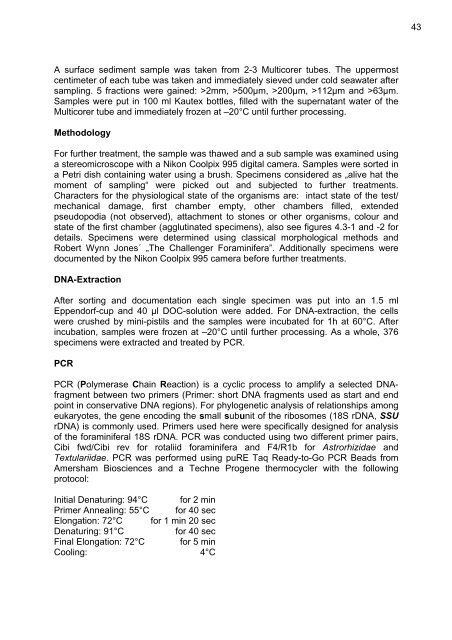the Expedition ARKTIS-XIX/4 of the research vessel POLARSTERN ...
the Expedition ARKTIS-XIX/4 of the research vessel POLARSTERN ...
the Expedition ARKTIS-XIX/4 of the research vessel POLARSTERN ...
Create successful ePaper yourself
Turn your PDF publications into a flip-book with our unique Google optimized e-Paper software.
A surface sediment sample was taken from 2-3 Multicorer tubes. The uppermost<br />
centimeter <strong>of</strong> each tube was taken and immediately sieved under cold seawater after<br />
sampling. 5 fractions were gained: >2mm, >500µm, >200µm, >112µm and >63µm.<br />
Samples were put in 100 ml Kautex bottles, filled with <strong>the</strong> supernatant water <strong>of</strong> <strong>the</strong><br />
Multicorer tube and immediately frozen at –20°C until fur<strong>the</strong>r processing.<br />
Methodology<br />
For fur<strong>the</strong>r treatment, <strong>the</strong> sample was thawed and a sub sample was examined using<br />
a stereomicroscope with a Nikon Coolpix 995 digital camera. Samples were sorted in<br />
a Petri dish containing water using a brush. Specimens considered as „alive hat <strong>the</strong><br />
moment <strong>of</strong> sampling“ were picked out and subjected to fur<strong>the</strong>r treatments.<br />
Characters for <strong>the</strong> physiological state <strong>of</strong> <strong>the</strong> organisms are: intact state <strong>of</strong> <strong>the</strong> test/<br />
mechanical damage, first chamber empty, o<strong>the</strong>r chambers filled, extended<br />
pseudopodia (not observed), attachment to stones or o<strong>the</strong>r organisms, colour and<br />
state <strong>of</strong> <strong>the</strong> first chamber (agglutinated specimens), also see figures 4.3-1 and -2 for<br />
details. Specimens were determined using classical morphological methods and<br />
Robert Wynn Jones´ „The Challenger Foraminifera”. Additionally specimens were<br />
documented by <strong>the</strong> Nikon Coolpix 995 camera before fur<strong>the</strong>r treatments.<br />
DNA-Extraction<br />
After sorting and documentation each single specimen was put into an 1.5 ml<br />
Eppendorf-cup and 40 µl DOC-solution were added. For DNA-extraction, <strong>the</strong> cells<br />
were crushed by mini-pistils and <strong>the</strong> samples were incubated for 1h at 60°C. After<br />
incubation, samples were frozen at –20°C until fur<strong>the</strong>r processing. As a whole, 376<br />
specimens were extracted and treated by PCR.<br />
PCR<br />
PCR (Polymerase Chain Reaction) is a cyclic process to amplify a selected DNAfragment<br />
between two primers (Primer: short DNA fragments used as start and end<br />
point in conservative DNA regions). For phylogenetic analysis <strong>of</strong> relationships among<br />
eukaryotes, <strong>the</strong> gene encoding <strong>the</strong> small subunit <strong>of</strong> <strong>the</strong> ribosomes (18S rDNA, SSU<br />
rDNA) is commonly used. Primers used here were specifically designed for analysis<br />
<strong>of</strong> <strong>the</strong> foraminiferal 18S rDNA. PCR was conducted using two different primer pairs,<br />
Cibi fwd/Cibi rev for rotaliid foraminifera and F4/R1b for Astrorhizidae and<br />
Textulariidae. PCR was performed using puRE Taq Ready-to-Go PCR Beads from<br />
Amersham Biosciences and a Techne Progene <strong>the</strong>rmocycler with <strong>the</strong> following<br />
protocol:<br />
Initial Denaturing: 94°C for 2 min<br />
Primer Annealing: 55°C for 40 sec<br />
Elongation: 72°C for 1 min 20 sec<br />
Denaturing: 91°C for 40 sec<br />
Final Elongation: 72°C for 5 min<br />
Cooling: 4°C<br />
43

















